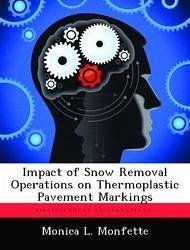This pilot study explored the effect snow removal operations have on thermoplastic pavement markings. Including snow removal as a separate independent variable is unique because much of the previous research performed on pavement marking degradation mentioned snow removal as a direct cause in a marking degrading more rapidly; however, it is mentioned as an afterthought and a suggestion to be considered in future research. This pilot study looked at 10 thermoplastic markings and all marking data were collected in the field, using a hand-held retroreflectometer. Data collected began 60 days after initial marking application and ended 12 months after initial marking application. Data were analyzed using linear regression. A significant finding was that during the first year, white thermoplastic markings located in the center of the road, and that are exposed to snow removal operations do not reach the apex of their break-in phase. Thus the start of the linear degradation phase does not start until at least one year after initial application.
Hinweis: Dieser Artikel kann nur an eine deutsche Lieferadresse ausgeliefert werden.
Hinweis: Dieser Artikel kann nur an eine deutsche Lieferadresse ausgeliefert werden.








